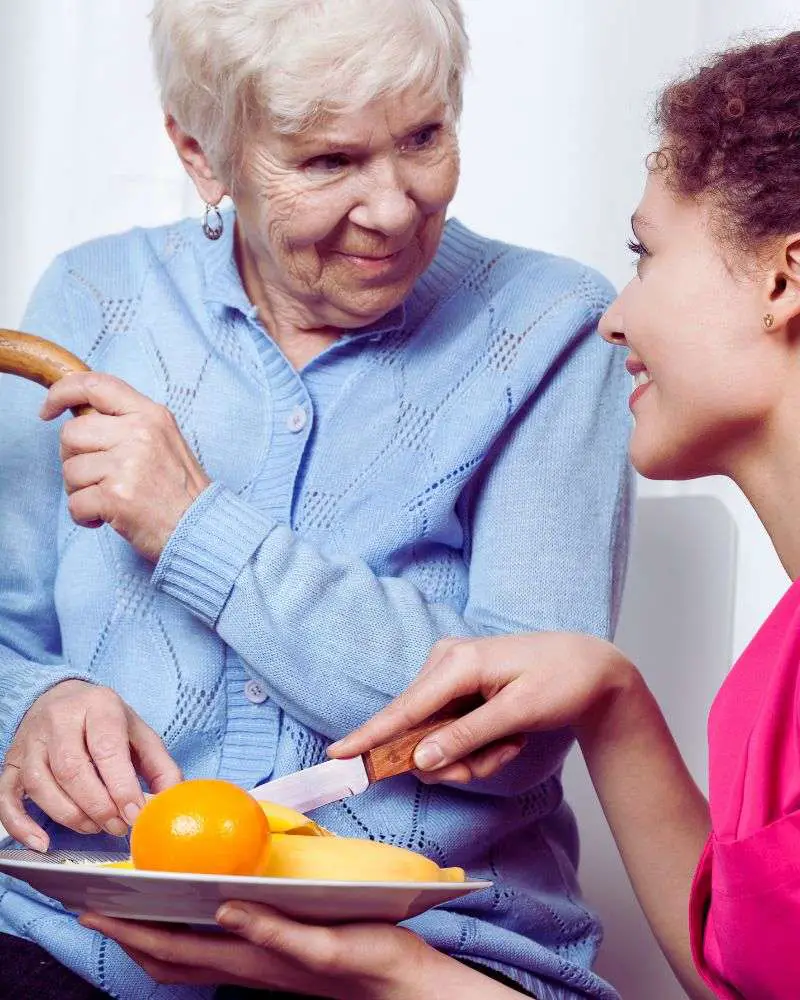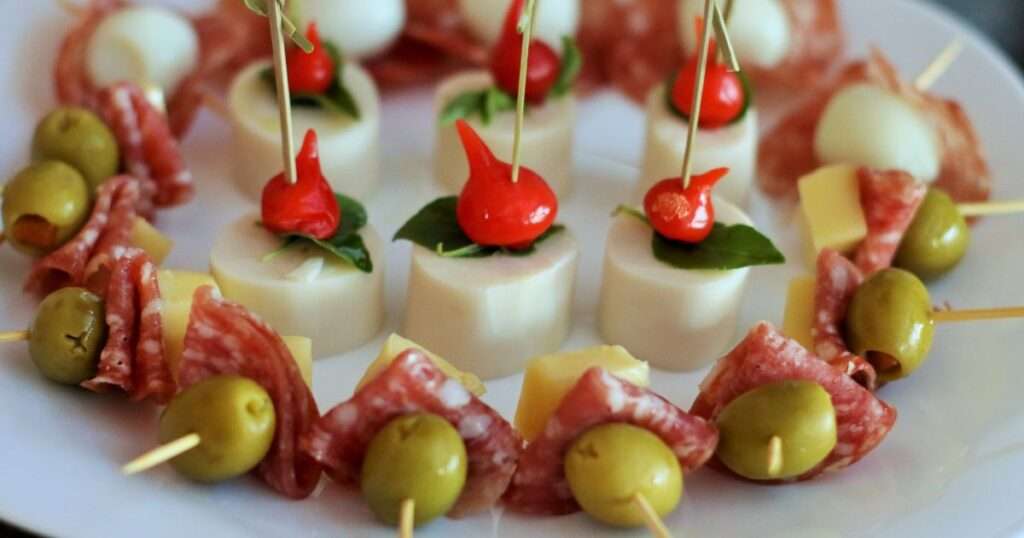As an Amazon affiliate, I may earn from qualifying purchases. Please read our Disclaimer and Privacy Policy.
Finger foods for the elderly are the perfect way to ensure your loved one is getting enough nutritients.
However, good nutrition for older adults can be challenging, especially when factors like decreased appetite, dental issues, or conditions such as Alzheimer’s disease or Parkinson’s disease impact food consumption.
Offering a variety of nutritious, easy-to-eat finger foods can greatly enhance the eating experience for elderly individuals while addressing their unique dietary needs.

Why Finger Foods are a Great Choice for the Elderly
Finger foods are a great way to help older adults maintain their independence during mealtimes, especially for those with mobility or cognitive impairments, such as dementia patients.
Family caregivers and family members alike often find that offering small, bite-size pieces of food is an easy way to encourage food intake and enhance nutritional status.
Additionally, these foods are simple to prepare and provide the right nutrients necessary for maintaining health in later years.
Here’s a list of finger foods that are not only easy to eat but also packed with essential vitamins, lean protein, and other important nutrients.

What if they don’t want healthy options?
When an elderly person refuses the finger foods you offer, it’s important to approach the situation with patience and understanding.
Factors such as changes in taste preferences, decreased appetite, or medical conditions like dementia can influence their food choices.
In these cases, it’s crucial to prioritize the person’s comfort and preferences while still encouraging balanced nutrition when possible.
Offering a variety of foods and involving them in meal decisions can help, as well as making the dining environment more enjoyable by eliminating distractions and presenting food in an appealing way.
However, forcing food is never recommended, as it can cause distress or frustration.
If the individual is on hospice care and expresses a strong desire for sweet treats or avoids vegetables, it’s essential to honor their wishes while focusing on quality of life over strict dietary guidelines.
At this stage, the goal of food intake shifts from ensuring optimal nutrition to promoting comfort, pleasure, and emotional well-being.
Sweet treats may provide a sense of comfort, and even small amounts of food, regardless of nutritional content, can help maintain a sense of independence and enjoyment during meals.
Family members and caregivers can continue to offer healthy options but should ultimately respect the person’s preferences as part of compassionate end-of-life care.

15 Safe and Nutritious Finger Foods for the Elderly
The following are 15 safe and nutritious finger foods for the elderly. We all have unique tastes in foods, and that doesn’t necessarily change as we age. While we want our loved ones to have nutritious snacks, it’s also important to recognize their wishes.
As long as the person’s nutritional needs are being met, I think it’s important to allow the person their own automony when making food decisions. In other words, give them what they want!
Disclaimer: I’m not a food expert or nutritionist. Please speak to a licensed nutritionist or physician for great options on snack items.
1. Peanut Butter on Whole Grain Crackers
Peanut butter is a great source of protein and healthy fats, making it a good option for elderly individuals.
When paired with whole grain crackers, it provides fiber, which supports digestive health. This combination can help boost energy and improve heart health, thanks to the essential nutrients found in whole grains.
2. Fresh Fruit Slices
Fresh fruit, such as apple or banana slices, are healthy finger foods that offer a range of essential vitamins and antioxidants.
Seasonal fruits are an easy way to boost vitamin C intake, helping to support the immune system. Cutting fruits into small pieces makes them easier to handle and chew for older people, especially those with dental concerns.
Read: Healthy Aging: Nutrition and Exercise Tips for Seniors
3. Hard-Boiled Eggs
Hard-boiled eggs (or hardboiled eggs) are a great source of protein, healthy fats, and essential vitamins. They are easy to prepare and serve in small portions, making them an excellent choice for elderly individuals with a decreased appetite. Eggs also contain choline, which may support cognitive function in dementia care.
4. Cottage Cheese with Fruit
Cottage cheese is another great source of protein and calcium.
Pairing it with fresh fruit provides a balanced snack that is soft and easy to eat. This combination helps meet dietary needs by offering a mix of macronutrients and essential vitamins to support overall health.
5. Small Sandwiches on Whole Grain Bread
Using whole grain bread for small sandwiches is a great way to ensure older adults get the benefits of whole grains, such as improved heart health and digestive function. Small sandwiches can be filled with nutrient-dense ingredients like egg salad or tuna salad, providing both protein and healthy fats.
6. Fish Sticks
Fish sticks are a good source of lean protein and omega-3 fatty acids, which are important for heart health and cognitive function.
Look for healthier options at grocery stores that are baked rather than fried to avoid unhealthy snacks with solid shortening.
7. Chicken Tenders or Nuggets
Chicken tenders or nuggets made from lean protein foods like grilled or baked chicken are great choices for elderly individuals.
They offer a good source of protein and can be served in small, bite-size pieces, which are easy to handle and eat without utensils.
8. Red Bell Pepper Strips
Bell peppers, especially red ones, are packed with vitamin C and antioxidants.
When cut into strips, they make for colorful, healthy finger foods that can easily be dipped into hummus or eaten alone. They also provide a great way to encourage vegetable consumption.
9. Steamed Broccoli Florets
Steamed broccoli is soft, easy to chew, and rich in essential vitamins like vitamin K and folate.
Broccoli supports heart health and is an excellent option for those on a soft food diet. Pair with a small plate of dip or melted cheese to make it more enticing.
Personally, I will become a very angry senior citizen if anyone tries to feed me steamed broccoli as a snack! Sure it makes great finger food for the elderly, but make sure they’re enjoying it and that it’s something they want.
10. Sweet Potato Fries
Sweet potato fries are delicious! I would be happy to serve them as finger foods for the elderly. I might even ask if the person is willing to share!
Baked sweet potato fries are a nutritious alternative to traditional potato chips.
Sweet potatoes are rich in fiber, vitamins A and C, and other essential nutrients that support the immune system and overall health. Cut into golden brown strips, they are easy to grab and enjoy.
11. Small Quiches
Yes please! There’s nothing better than a tiny quiche for a snack. They can be basic or jam-packed with vegetables and lean protein like eggs and cheese.
I love the idea of small quiches as finger foods for the elderly because they can be made in advance. You can serve them in smalll, easy-to-handle portions as well.
12. Greek Yogurt with Chia Seeds
Greek yogurt is a great source of protein and calcium, and when paired with chia seeds, it provides additional fiber and omega-3 fatty acids. This soft, nutrient-dense snack supports digestive health and is a good choice for those with a decreased appetite.
Again, I’m not a dietician or physician, but I would get the all-clear from a medical professional before serving chia seeds to an elderly person. The reason is because they may not be safe for people with swallowing difficulties.
According to Very Well Health, chia seeds may influence how the following medications are absorbed or used by the body:
- diabetes medications
- blood pressure medications
- blood-thinning medications
- may interact with specific nutrients and decrease the absorption of zinc, calcium, and iron supplements.
13. Tuna Salad on Whole Grain Crackers
Tuna salad is packed with lean protein and omega-3 fatty acids, promoting heart and brain health. Serving it on whole grain crackers adds a fiber boost, making it a nutritious finger food option for older adults.
14. Dark Chocolate Squares
For a sweet treat, dark chocolate is a healthier option compared to sugary snacks. It’s rich in antioxidants and can help improve heart health. Offering small pieces as a snack allows for portion control, helping to meet dietary needs without consuming excessive calories.
15. Vegetable-Stuffed Mini Pita Pockets
Mini pita pockets filled with veggies like bell peppers, spinach, or cucumbers are a nutritious and delicious option. This finger food offers an easy way to increase vegetable consumption while providing essential vitamins and minerals. Pita pockets can be made small enough for easy handling.
Conclusion
Providing nutritious finger foods is an easy way to enhance food intake in elderly individuals, especially those with dietary concerns or cognitive impairments like Alzheimer’s disease or Parkinson’s disease.
Family caregivers can create a variety of healthy finger foods, ensuring that older adults receive the right nutrients to support their health.
These foods not only improve nutritional status but also offer a sense of independence, making mealtime more enjoyable and stress-free.

